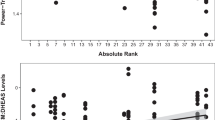Abstract
Squirrel monkeys (Saimiri sciureus, Iquitos) were exposed to a sequence of three stresses: A live snake, ether anesthesia, and physical restraint. Plasma cortisol concentrations were determined both following each stress exposure and before and after the sequence of stresses. Dominant males demonstrated lower unstressed plasma cortisol levels than subordinates. Although the form of the relationship between adrenal activity and social dominance differs for the types of stress, dominant animals always show the greatest adrenal reactivity to stress.
Similar content being viewed by others
References
Brown, G., L. Grota, D. Penny, &S. Reichlin, 1970. Pituitary adrenal function in the squirrel monkey.Endocrinol., 86: 519–529.
Candland, D. K., D. C. Bryan, B. L. Nazar, K. J. Kopf, &M. Sendor, 1970. Squirrel monkey heartrate during formation of status orders.J. Comp. Physiol. Psychol., 70: 417–423.
———— &A. I. Leshner, 1974. A model of agonistic behavior. In:Limbic and Autonomic Nervous System Research,L. V. DiCara (ed.), Plenum Press, New York, pp. 137–163.
Clark, L. &E. Nakashima, 1972. Measurement of social dominance in squirrel monkeys.Behav. Res. Meth. Instr., 4: 142–144.
DuMond, F. V. &T. C. Hutchinson, 1967. Squirrel monkey reproduction.Science, 158: 1467–1470.
Glick, D., D. von Redlich, &S. Levine, 1964. Fluorometric determination of corticosterone and cortisol in 0.02–0.05 ml. of plasma or submilligram samples of adrenal tissue.Endocrinol., 74: 653–655.
Hayama, S., 1966. Correlation between adrenal gland weight and dominance rank in caged crab-eating monkeys.Primates, 7: 21–26.
Lang, C. M., 1968. The laboratory care and clinical management ofSaimiri (squirrel monkeys). In:The Squirrel Monkey,L. A. Rosenblum &R. W. Cooper (eds.), Academic Press, New York, pp. 393–416.
Leshner, A. I. &D. K., Candland, 1972. Endocrine effects of grouping and dominance rank in squirrel monkeys.Physiol. Behav., 8: 441–445.
———— & ————, 1973. The hormonal basis of aggression.New Scientist, 57: 126–128.
Levine, M. D., T. P. Gordon, R. H. Peterson, &R. M. Rose, 1970. Urinary 17-OHCS response of high- and low-aggressive rhesus monkeys to shock avoidance.Physiol. Behav., 5: 919–924.
Louch, C. D. &M. Higginbotham, 1967. The relation between social rank and plasma corticosterone levels in mice.Gen. Comp. Endocrinol., 8: 441–444.
Sassenrath, E. N., 1970. Increased adrenal responsiveness related to social stress in rhesus monkeys.Horm. Behav., 1: 283–298.
Welch, B. L. &A. S. Welch, 1969. Aggression and the biogenic amine neurohumors. In:Aggressive Behaviour,S. Garattini &E. B. Sigg (eds.), John Wiley, New York, pp. 188–202.
Author information
Authors and Affiliations
Additional information
This work was part of an honor's thesis completed by the first author for the A. B. degree in Animal Behavior at Bucknell University.
About this article
Cite this article
Manogue, K.R., Leshner, A.I. & Candland, D.K. Dominance status and adrenocortical reactivity to stress in squirrel monkeys (Saimiri sciureus). Primates 16, 457–463 (1975). https://doi.org/10.1007/BF02382742
Received:
Accepted:
Issue Date:
DOI: https://doi.org/10.1007/BF02382742




